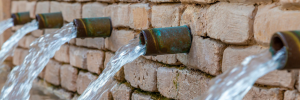
World Water Day: Groundwater is SA’s most vital hidden resource
Tuesday (22 March) is World Water Day with National Water Week being celebrated from 21-27 March. In an opinion piece for Cape Times, Ritshidze Nenweli and Drs Andrew Watson and Reynold Chow (Department of Earth Sciences) write why the sustainable management of South Africa's groundwater resources is critical to the country's future.
- Read the article below or click here for the piece as published.
Ritshidze Nenweli & Reynold Chow*
South Africa is a semi-arid region characterised by high evaporation and low precipitation rates. Parts of the country frequently experience less than average rainfall. When these periods of low rainfall are prolonged, droughts ensue. During periods of drought, surface water reservoirs like the Theewaterskloof and Wemmershoek Dams, are typically the first to noticeably dry up.
Many of us still remember the recent drought in the Western Cape. In early 2017, the collective reservoir levels of the Western Cape Water Supply System (WCWSS) hovered around 20% of its full capacity. Later that year, the City of Cape Town designated the term “Day Zero" whereby WCWSS collective dam levels were expected to drop below 13.5% by April 2018 and water supply to most private taps would be shut-off.
Fortunately, “Day Zero" never arrived due to water-use restrictions and the exploitation of groundwater. This shows us that groundwater plays a vital role as an alternative source of water, especially during periods of drought. But what exactly is groundwater and how do we keep track of it? These are important questions, especially given this year's World Water Day (22 March) theme, which is “Groundwater: making the invisible visible".
Groundwater is water found beneath the earth's surface in cracks and open spaces between rocks, sand, and soil. It is stored and moves through geologic formations called aquifers. Groundwater makes up 95% of the earth's accessible liquid freshwater and its availability is mostly controlled by geology and climate. Research has shown that most aquifers in South Africa are composed of fractured crystalline and sedimentary rock.
In an article for Water Policy (2021), Harrison Pienaar and his co-authors pointed out that South Africa has approximately 7,500 million cubic meters per year of available renewable groundwater under drought conditions. That volume would fill approximately three million Olympic swimming pools each year. Current groundwater use in the country has been estimated to be between 2,000 and 4,000 million cubic meters annually, thus there is potential to increase our groundwater use in future.
South Africa's groundwater is mostly used for rural water supply and irrigation. According to the Department of Water Affairs (DWA; 2010), the majority of small household water users in rural communities depend on groundwater. The DWA (2013) estimates that groundwater is used for: 65% agriculture (60% for irrigation and about 5% for livestock), 13% for mining, 13% for domestic water supply in towns and cities, 3% for industry, and 6% for rural water supply (mainly domestic and non-commercial gardening).
Since South Africa is a water-scarce country, many citizens have drilled their own private boreholes without proper permits. This has led to a lack of data regarding the number of active groundwater users as well as the total quantities of groundwater being extracted. This critical knowledge gap makes managing our precious groundwater resources very difficult. To help bridge this knowledge gap, we have been using data from the Gravity Recovery and Climate Experiment (GRACE) to identify and monitor groundwater depletion in the Western Cape.
GRACE is a partnership between the American National Aeronautics and Space Administration (NASA) and the German Research Centre for Geosciences. GRACE consists of two satellites that orbit the earth and detect changes in its mass. Water being dense and mobile, is assumed to contribute to most of the changes in earth's mass. Thus, by measuring the change in earth's gravity field, we can map changes in groundwater storage.
The advantage of GRACE data is that it is easily accessible and up-to-date. GRACE estimates change in total water storage, which is the sum of groundwater, surface water, soil moisture and snow water storage. To estimate groundwater storage, we must subtract the other components from total water storage. We hypothesise that groundwater is the major contributor to the changes in total water storage in the Western Cape. Our current research focuses on analysing for correlations between total water storage and observed groundwater storage.
Unmonitored and unregulated abstraction of groundwater, especially under climate change, poses a significant risk to South Africa's water security. Groundwater is a vital hidden source of water during droughts and an everyday source of water in rural communities. As we celebrate World Water Day and our own National Water Week (21 ̶ 27 March), we should remind ourselves that the sustainable management of our groundwater resources is critical to the country's future.
*Ritshidze Nenweli is a Master's student and Dr. Reynold Chow a hydrogeology lecturer in the Department of Earth Sciences at Stellenbosch University (SU). Dr Andrew Watson is affiliated with the SU Water Institute.
